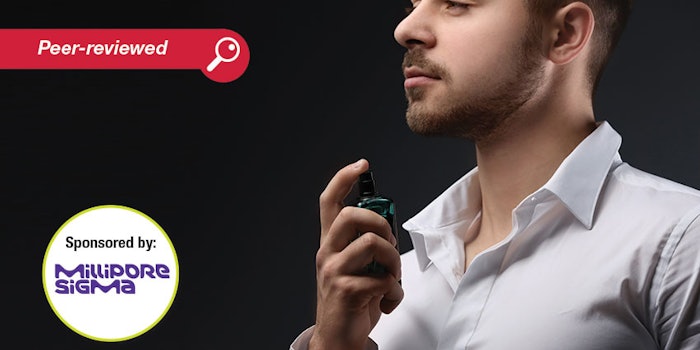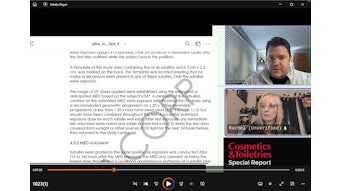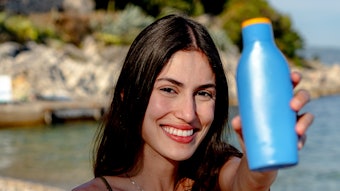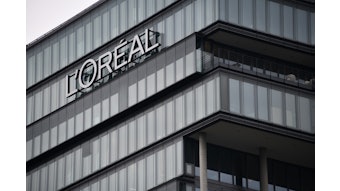
Read articles related to this in the November/December 2020 issue. . .
The most important aspect of a fragrance is its safety. No fragrance, no matter how amazing it may smell, can go to market if it is not safe. Fortunately, there is clear-cut guidance to establish that safety. The Research Institute for Fragrance Materials (RIFM)1 performs the scientific part, then the International Fragrance Association takes that science and issues the guidelines to be followed by all responsible companies in the industry. The conclusions of RIFM scientists are additionally vetted through the independent oversight of the Expert Panel for Fragrance Safety.2
All of these relevant guidelines and supporting materials are on the IFRA website,3 and many of the foundation documents are easily accessible.4 This material can be challenging for anyone lacking a degree in toxicology, however. As such, this article is intended to elucidate, for the non-specialist, the work the fragrance industry has performed in order to assure the safety of its products—especially in consideration of today’s hyper-sensitized, over-washed skin.
Early Aroma Evaluation
RIFM was established in 1966 and IFRA in 1973, so there is a long history of aroma chemical safety evaluation. But toxicology, the needs of industry, regulatory considerations and consumer expectations have all changed many times over those years. Beginning in the early 2000s, RIFM experts released a series of guidance documents5-7 to explain in detail the science behind the RIFM approach to safety. This process culminated in October 2008 in a complete issue of the Regulatory Toxicology and Pharmacology journal devoted to Quantitative Risk Assessment (QRA)—i.e., RIFM’s approach to skin safety, led by Anne Marie Api, Ph.D.7
See related sidebar: [sponsored] MilliporeSigma: Amplify your senses, confidently
As valuable as the guidance documents are, they do not provide a single unified approach to RIFM’s work. As such, a series of foundation documents8-11 paved the way for what became the Criteria II paper,12 which established a unified approach to RIFM science, explaining, step by step, how a fragrance material enters the system and a safety evaluation is produced in the end.
Reaching an Endpoint: The RIFM Decision Tree
Many different endpoints are evaluated, so the details are different for skin allergic reactions and environmental impact, for example. As a result, a decision tree incorporating concepts from the latest approaches to safety evaluation was developed for a clearer road map to every assessment. This decision tree has four steps, which are considered here, in order. The goal of the RIFM decision tree is to reach the proper safety evaluation with the fewest steps, making the process as efficient as possible without sacrificing the accuracy of results.
Step One: Evaluate Available Safety Data
Step One (see Figure 1) is to evaluate the available data on the precise material under consideration. If there is sufficient high-quality data, an endpoint assessment can be made. RIFM assesses the following endpoints: genotoxicity, repeated dose toxicity, reproductive and developmental toxicity, skin sensitization, phototoxicity and photoallergy, respiratory and environmental. If insufficient data exists for any of the endpoints, the study proceeds to Step Two for those endpoints.
Step Two: Use Read-across to Fill the Data Gap
The read-across approach in Step Two (see Figure 2) is used when essential safety data is lacking for the evaluation of a specific endpoint. It attempts to fill the data gap with information gleaned from an analog or relevant chemical category. Of course, this must be considered carefully to assure the process meets the highest scientific standards.
Using read-across, the toxic endpoint of the substance in question is determined from the same endpoint for a related tested material. The two chemicals must be similar in structure, properties and metabolic by-products. It is necessary to locate a group of substances that both includes the target chemical and contains relevant toxicology information. It is important that the information obtained is of high quality—i.e., meets OECD or other relevant guidelines, etc., and that the uncertainty of the process is acceptable for the purposes of filling the data gap. RIFM uses clustering to assist in read-across; the details explained in Dale, et al.13
A wide range of in silico tools may be used to assess the genotoxic potential of a material. Examples are the deductive estimate of risk from existing knowledge (DEREK) and toxicity prediction by komputer assisted technology (TOPKAT). For a review of the methods used in in silico toxicology, see Richard.14
RIFM also has available to its members a Skin Absorption Model (SAM) the principles of which are described by Shen, et al.15 An additional assessment tool available to members is the Toxicological Data Search Engine (TDSE). An in vitro gene mutagenicity assay such as Ames (OECD, 1997) or an in vitro cytogenicity assay such as the in vitro Micronucleus Test (OECD, 2010b) can also be utilized. If an appropriate analog can be attained at this point, or the in vitro tests are conclusive, the assessment of the endpoint can be made. If not, the process proceeds to Step Three.
Step Three: Assess the Exposure Threshold
The Threshold of Toxicological Concern (TCC) (see Figure 3) was an important step introduced in the Criteria II paper and elaborated on by Kroes.11 It derives from work performed by the food industry with the U.S. Food and Drug Administration (FDA) to address chemicals present at very low levels. The assumption is that a chemical present at a low level with minimal expected toxicity will be safe. As with any toxicological concept, there is an additional level of consideration; in this case, the Cramer Classes of the material.
The Cramer Classes themselves were derived from a decision tree16 and include the following:
• Class I, which contains substances of simple chemical structure with known metabolic pathways and innocuous end products that suggest a low order of oral toxicity.
• Class II, which contains substances that are intermediate. These possess structures that are less innocuous than those in Class I but they do not contain structural features that are suggestive of toxicity; unlike those in Class III.
• Class III, which contains substances with chemical structures the give no initial impression of safety and may even suggest significant toxicity.
Different TTC exposure values using these Cramer Classes have resulted in different values by different researchers or assumptions. For fragrance materials without special toxicological alerts, values of Cramer Classes I, II and III have exposure limits of 30, 9 and 1.5 μg/kg bw/day, respectively.12 For a discussion on how the Cramer Class results are determined by Toxtree, the OECD QSAR Toolbox and expert judgment, see Bhatia.17
Step Four: Generate Required Data
Hopefully the endpoint assessment will be reached by Step Three but if not, it may be possible to get a result by refining the exposure or other risk management approaches. If not, additional in vitro testing may work. As a last resort, in vivo testing may be required (see Figure 4)—only conducted if absolutely necessary. However, many steps are required and regardless of the endpoint under consideration, the decision tree has given the result with the best science in the most efficient way.
Assuring Dermal Safety
The cosmetic industry has a particular interest in dermal safety and avoiding allergic reactions. In this area, RIFM has evolved several approaches (QRA, QRA 2, DST, etc.) and outside alliances (e.g., Crème Global and the European Dermato Epidemiology Network (EDEN) project). Of course, the decision tree still dictates the basic approach but as with each endpoint, specific concerns are dealt with in the evaluation of dermal safety.
Quantitative Risk Assessment: Quantitative Risk Assessment (QRA) is the basic tool, published in 2008 and refined into QRA 2 with revised epidemiological and cumulative exposure information. Its aim is to provide an acceptable exposure level for an aroma chemical, with the ultimate goal being of virtually eliminating fragrance allergy in the general public.
The starting point is:
Acceptable Exposure Level =
NOEL/Uncertainty Factor
NOEL is the No Observable Effect Level, i.e., the highest dose or exposure level of a substance or material that produces no noticeable toxic effect. The uncertainty factor takes into account all the possible individual variables and includes a large number of safety factors, as toxicology is a highly conservative science.
The QRA 2 form of this relationship is:
Acceptable Exposure Level (AEL) =
WoE NESIL/SAF
where WoE is Weight of Evidence, NESIL is No Expected Sensitization Induction Level, and SAF is the Sensitization Assessment Factor.
In the comparison of Acceptable Exposure Levels (AEL) to calculated Consumer Exposure Level (CEL), it is required that AEL ≥ CEL, in order to be acceptable.
NESIL data can come from a variety of published and other sources and may be highly variable and of questionable value. The Weight of Evidence of NESIL is the value determined by the RIFM Expert Panel—an independent group of academic experts with a diversity of scientific specialties and no ties to the fragrance industry, based on a careful analysis of all the available data.
The SAFs for QRA 2 are shown in Figure 5, with the total SAF being the multiplicative product of the individual components.
The version of QRA 2 as presented in the Criterial II publication involved collaboration with two other organizations. EDEN conducted an international study on the prevalence of fragrance ingredient contact allergy in the general population18 that informed the QRA II input. The Crème RIFM Aggregate Exposure Model19 assesses exposure for consumers across Europe and the United States with consumer usage data on a variety of products derived from a study of more than 36,000 consumers. A tool is available from RIFM for companies to determine consumer exposure.20
Dermal Sensitization Threshold: The Dermal Sensitization Threshold (DST) applies the concept of the TTC to the evaluation of dermal sensitization.21 The DST establishes a level below which there is no appreciable risk for the induction of sensitization, and is based on a probabilistic analysis of data for a diverse range of known chemical allergens. The levels derive from reactions with peptides: non-reactive substance = 900 μg/cm2; reactive substance = 64 μg/cm2.
The decision tree for skin sensitization is a special case, involving the following steps (see further details in the Criteria II paper):12
1. Step one: evaluate available data
2. Step two: read-across
3. Step three: DST
4. Step four: data generation
Of course, this is essentially the same as the basic decision tree process described above for RIFM in general, simply modified to take into account specific concerns related to skin sensitization.
Setting Standards
As noted, RIFM science is conducted as an independent research institute with an outside Expert Panel and extensive publications in peer-reviewed journals. The actual distillation of the science into the guidelines is the domain of IFRA. These guidelines are updated regularly with amendments. A particularly significant one—the 49th Amendment—was made public on January 10, 2020.
Guidelines come in several varieties, such as specifying a particular quality for a raw material, or the use of antioxidants. IFRA sets quantitative standards in a variety of product categories. In the 49th amendment, some subcategories have addressed phototoxicity and systemic toxicity. Phototoxic restrictions take into account the difference between leave-on and rinse-off products. Toxic effects are generally categorized according to the site of the effect. Cases where toxic effects may occur at multiple sites are known as systemic toxicity, and some subcategories have been created for this reason.
A Schiff base is a reaction product of an aldehyde and an amine (see Figure 6). One requirement of the 49th Amendment is that Schiff bases must be considered completely disassociated to perform the regulatory analysis of a fragrance. Thus, Aurantiol must be considered 56.4% hydroxycitronellal unless proven otherwise.
A difficult issue for fragrance safety comes when natural products are considered—what RIFM prefers to describe as Natural Complex Substances (NCSs). Levels of restricted substances in NCSs are provided in Annex I to the IFRA Standards.22 These levels must be considered for regulatory compliance. If a company has analytical data on the exact material used, that data can be substituted. Some natural substances have their own standards that also must be taken into account.
Conclusions
IFRA guidelines certainly are the best assurance of dermal safety but they are not the only concern for compliance to all the regulations or requirements to which fragrances are subjected. There are EU cosmetic regulations and allergen labeling requirements. Fragrances are chemicals and subject to all chemical regulations like REACH, the Canadian DSL and California Prop. 65. Fragrances may also be required to be kosher, halal, non-GMO, Safer Choice, phthalate-free, etc. Fragrances require a safety data sheet (SDS) and specification sheet, and all the pictograms that the ECHA site provides.23
The final output of all this science is a certificate of conformity for every fragrance placed in commerce, providing safe levels of use in different applications. The goal is to minimize adverse reactions to fragrance in the general population. The 49th Amendment is not the end of the process, however; new advances in the science of toxicology and new predictive tools will continue to shape the future of fragrance safety but RIFM in the Criteria II document and IFRA in the 49th Amendment have created a foundation deep enough to embrace any future challenges.
References
- RIFM (accessed 2020, Sep 17). https://www.rifm.org
- Expert Panel for Fragrance Safety. (accessed 2020, Sep 17). http://fragrancesafetypanel.org
- IFRA (accessed 2020, Sep 17). https://ifrafragrance.org
- Food and Chemical Toxicology Fragrance Material Safety Assessment Center. (accessed 2020, Sep 17). Safety assessment sheet database. Available at: http://fragrancematerialsafetyresource.elsevier.com
- Ford, R.A., Domeyer, B., Easterday, O., Maier, K. and Middleton, J. (2000). Criteria for development of a database for safety evaluation of fragrance ingredients. Regul Toxicol Pharmacol 31(2 Pt 1) 166-181; doi:10.1006/rtph.1999.1362
- Cadby, P.A., Troy, W.R. and Vey, M.G. (2002). Consumer exposure to fragrance ingredients: Providing estimates for safety evaluation. Regul Toxicol Pharmacol 36(3) 246-252; doi: 10.1006/rtph.2002.1581
- Salvito, D.T., Senna, R.J. and Federle, T.W. (2002). A framework for prioritizing fragrance materials for aquatic risk assessment. Environ Toxicol Chem 21(6) 1301-1308.
- Api, A.M., Basketter, D.A., Cadby, P.A., et al. (2008). Dermal sensitization quantitative risk assessment (QRA) for fragrance ingredients. Regul Toxicol Pharmacol 52(1) 3-23; doi:10.1016/j.yrtph.2007.10.008
- Wu, S., Blackburn, K., Amburgey, J., Jaworska, J. and Federle, T. (2010). A framework for using structural, reactivity, metabolic and physicochemical similarity to evaluate the suitability of analogs for SAR-based toxicological assessments. Regul Toxicol Pharmacol 56(1) 67-81; doi:10.1016/j.yrtph.2009.09.006
- Kroes, R., Renwick, A.G., Cheeseman, M., et al. (2004). Structure-based thresholds of toxicological concern (TTC): Guidance for application to substances present at low levels in the diet. Food Chem Toxicol 42(1) 65-83; doi:10.1016/j.fct.2003.08.006
- Kroes, R., Renwick, A.G., Feron, V., et al. (2007). Application of the threshold of toxicological concern (TTC) to the safety evaluation of cosmetic ingredients. Food Chem Toxicol 45(12) 2533-2562; doi:10.1016/j.fct.2007.06.021
- Api, A.M., Belsito, D., Bruze, M., et al. (2015). Criteria for the Research Institute for Fragrance Materials, Inc. (RIFM) safety evaluation process for fragrance ingredients. Food Chem Toxicol 82 Suppl: S1-S19; doi:10.1016/j.fct.2014.11.014
- Date, M.S., O'Brien, D., Botelho, D.J., et al. (2020). Clustering a chemical inventory for safety assessment of fragrance ingredients: Identifying read-across analogs to address data gaps. Chem Res Toxicol 33(7) 1709-1718; doi:10.1021/acs.chemrestox.9b00518
- Richard, A.M. (1998). Structure-based methods for predicting mutagenicity and carcinogenicity: Are we there yet? Mutat Res 400(1-2) 493-507; doi:10.1016/s0027-5107(98)00068-2
- Shen, J., Kromidas, L., Schultz, T. and Bhatia, S. (2014). An in silico skin absorption model for fragrance materials. Food Chem Toxicol 74 164-176; doi:10.1016/j.fct.2014.09.015
- Cramer, G.M., Ford, R.A. and Hall, R.L. (1978). Estimation of toxic hazard—A decision tree approach. Food Cosmet Toxicol 16(3) 255-276; doi:10.1016/s0015-6264(76)80522-6
- Bhatia, S., Schultz, T., Roberts, D., Shen, J., Kromidas, L. and Marie Api, A. (2015). Comparison of Cramer classification between Toxtree, the OECD QSAR Toolbox and expert judgment. Regul Toxicol Pharmacol 71(1) 52-62; doi:10.1016/j.yrtph.2014.11.005
- Rossi, M., Coenraads, P.J., Diepgen, T., et al. (2010). Design and feasibility of an international study assessing the prevalence of contact allergy to fragrances in the general population: The European Dermato-Epidemiology Network Fragrance Study. Dermatology 221(3) 267-275; doi:10.1159/000319757
- Safford, B., Api, A.M., Barratt, C., et al. (2017). Application of the expanded Crème RIFM consumer exposure model to fragrance ingredients in cosmetic, personal care and air care products. Regul Toxicol Pharmacol 86 148-156; doi:10.1016/j.yrtph.2017.02.021
- Crème RIFM (accessed 2020, Sep 17). Scientific model. Available at: www.cremeglobal.com/creme-rifm
- Safford, R.J. (2008). The Dermal Sensitization Threshold—a TTC approach for allergic contact dermatitis. Regul Toxicol Pharmacol 51(2) 195-200; doi:10.1016/j.yrtph.2008.02.010
- IFRA (accessed 2020, Sep 17). Template for certificate of conformity to the IFRA Standards. Available at: https://ifrafragrance.org/safe-use/standards-documentation
- ECHA (accessed 2020, Sep 17). Search for chemicals. Available at: https://echa.europa.eu/











